IUCN/SSC Otter Specialist Group Bulletin

©IUCN/SCC Otter Specialist Group
Volume 36(A) Special Issue (April 2019)
 PROCEEDINGS OF THE 14th INTERNATIONAL OTTER CONGRESS
PROCEEDINGS OF THE 14th INTERNATIONAL OTTER CONGRESS
8 - 19th April 2019
Tangjiahe, China
Notes on Distribution, Status and Ecology of Asian Small-Clawed Otter (Aonyx cinereus) in Diaoluoshan National Nature Reserve, Hainan Island, China
Li Fei 1 , Luo Fanqiang 2 , and Bosco P.L. Chan 1 *
Kadoorie Farm & Botanic Garden, Lam Kam Road, Tai Po, Hong Kong.
2Hainan Diaoluoshan National Nature Reserve, Hainan Province, China.
* Corresponding Author boscokf@kfbg.org
 Li Fei (right) and Bosco Chan (left) in northwestern Yunnan. |
 Luo Fanqiang in the Diaoluoshan otter habitat |
Received 27th November 2019, accepted 8th May 2020
Abstract: Due to decades of wildlife and forest exploitation, otters on the Chinese island of Hainan have undergone a dramatic population crash. The last confirmed record of Asian small-clawed otter (Aonyx cinereus), in Mt. Diaoluoshan in southeast Hainan, dated back to 2009. At the beginning of 2017, we launched an otter conservation project at Diaoluoshan National Nature Reserve, Hainan. Our fieldwork confirmed the continued existence of Asian small-clawed otter, in low densities, in three major streams below 1,000 m asl. Decapods were the major food items based on spraint found. Compared to previous studies, latrine sites appeared to have shifted upstream, most likely to avoid the intense human disturbance in the lower reaches. Enhancing patrolling effort and curbing human disturbance are keys to the survival of the highly threatened Asian small-clawed otter in Mt. Diaoluoshan, which is the only reliable site for the species in Hainan.Keywords: Aonyx; distribution; status; conservation; spraint
INTRODUCTION
Asian small-clawed otter (ASCO hereinafter, Aonyx cinereus) is one of the five otter species found in Asia (Duplaix and Savage, 2018). It has a large, mainly tropical, distribution range, extending from South Asia eastwards through Southeast Asia to southern China, as well as on the Greater Sunda Islands and Palawan (Wright et al., 2015). Populations of ASCO are in general decline throughout its wide range; in addition to widespread threats such as habitat loss, poaching and pollution, the recent boom in the illegal pet trade targeting this species is a growing threat to its survival (Duplaix and Savage, 2018).
Hainan, a mountainous island with a land area of ca. 33,900 km2, is at the southernmost tip of China in the Gulf of Tonkin. Located in the Asian-Pacific monsoon belt between 18-20oN in latitude, this tropical island has ample freshwater bodies which have the potential to support healthy otter populations.
Two species of otter have been recorded in Hainan, namely the Eurasian otter Lutra lutra and ASCO (Xu, 1983). Local gazetteers between 1511 to 1934 reported otters throughout the island (Yan, 2008). The British naturalist Robert Swinhoe (1836-1877) procured skins of both species from local hunters in the environs of major human habitations back in the 19th century. Island-wide faunal survey conducted in the 1960s still recorded otters across the forested landscape of the island, with the Eurasian otter occurring in both lowlands and mountains whereas ASCO was restricted to the mountains (Xu, 1983). However, otter pelts and body parts are considered valuable commodities in China and they were widely hunted since the 1950s (Li and Chan, 2018). The pelt harvest statistics from Hainan dropped by at least 80% between the 1950s and the 1980s (Xu, 1983; 1984). Both species are nowadays highly endangered in Hainan following rampant harvesting and, in later years, poaching pressures. According to the last systematic otter survey on Hainan Island conducted between 2006-2009, ASCO was found to be restricted to the island’s remote interior, and Mt. Diaoluoshan (hereinafter DLS) in southeast Hainan was the only site with a relatively stable population (Lei, 2009). Li (2005) studied the distribution of ASCO in DLS between 2003 and 2004 and found otter signs in 4 out of 30 transects along three major streams. Lei (2009) surveyed another major stream in DLS between 2006 and 2009, and reported microhabitat use and diet of the local ASCO population.
In January 2017, the Hong Kong-based conservation NGO Kadoorie Farm & Botanic Garden (KFBG) started a collaboration with the authority of Hainan Diaoluoshan National Nature Reserve (DLSNNR) to study and conserve the dwindling ASCO population. KFBG provided funding and training for the establishment of an ASCO Monitoring Team, which is the first of its kind in China. The aims are to conduct baseline study on the distribution, status and ecology of ASCO in DLSNNR, and to enhance protection effort at key habitats identified by the survey. We hereby report our preliminary results and make comparisons with previous studies.
STUDY AREA
DLSNNR is located in southeast Hainan at ca. 18°40′08″-18°49′19″N, 109°45′05″-109°57′07″E, has a size of ca. 190 km2 and an elevation range of 100-1,500 m asl. It encompasses a large part of the rugged Mt. Diaoluoshan mountain range, and supports one of the last remaining lowland rainforests in Hainan and is the headwater of the Lingshui River. This coastal mountain is within the East Asian typhoon belt and receives copious rainfall, with an annual precipitation of 1,870-2,760 mm, mainly fall in the monsoon rainy season between June-October (Jiang, 2006). The southern slopes of DLS has a gentler gradient with an extensive stream network; major streams include Baishui River, Nanxi River, Diaoluo River and Dali River (Fig. 1).
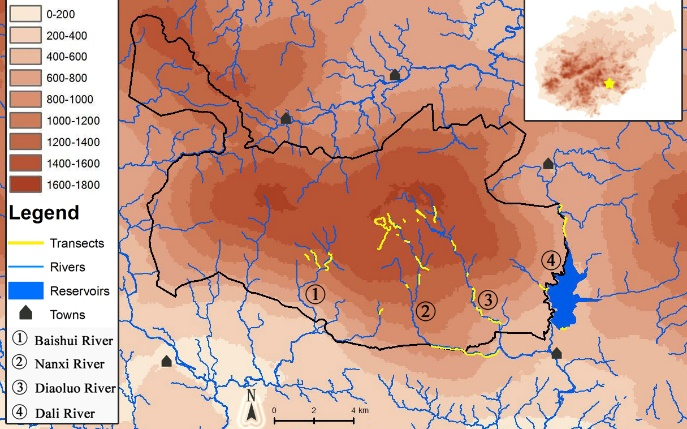
METHOD
Four rangers from DLSNNR were selected, trained and funded by KFBG to form an ASCO Monitoring Team. Survey and monitoring works were carried out in the period of January 2017 to December 2018. Two to four surveys were conducted each month depending on weather conditions, with reduced frequency during the monsoon season between June to October. Survey sites covered four streams on the southern slopes of DLSNNR between 134 - 1,125 m asl, which overlap with previous otter distribution records (Xu, 1983; Li, 2005; Lei, 2009). Since otters are secretive, and more so for a heavily-disturbed population such as the one in DLS, our survey relied heavily on visual searching of otter signs (spraints, holts, tracks and food remains) by foot along streams and reservoirs, with effort focusing on instream and bankside boulders, fallen logs and sandbars. Detail field survey methodology followed Li & Chan (2018). All survey routes and otter signs found were marked by GPS and signs photographed.
Camera traps (Loreda L710, Loreda, Shenzhen, China; Ltl Acorn 6210, AcornCamera, Shenzhen, China) were deployed at 44 locations where otter signs were detected. Cameras were positioned 30-50 cm above ground, and the sensitivity was set to ‘high’.
RESULTS
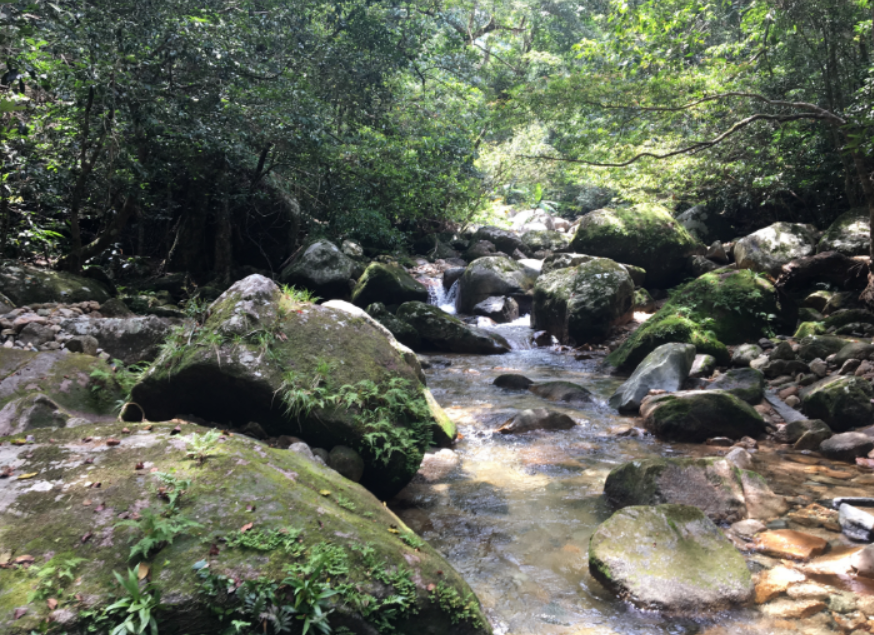
Overall, a total of 36 transects totaling 26.93 km in the four selected streams were repeatedly walked; these were re-surveyed between 2-5 times during the study period; transects with spraint records were walked more frequently (Fig. 1). In total, Baishui River was walked 30 times, Nanxi River 25 times, Diaoluo River 12 times, and Dali River 10 times. Forty-four otter spraints were found, of which 33 (75.00%) were found in Baishui River, eight (18.18%) in Nanxi River, three (6.82%) in Diaoluo River, and none in Dali River. We found no other signs apart from spraints. Stream sections with otter spraints were characterized by gentle gradient with good riparian forest cover, boulder-strewn with typical step-pool formation and a gravel substrate (Fig. 2). Most spraints consisted entirely of decapods remains, but fish bones were also found in a few samples (N = 2) (Fig. 3). We were not aware of any literature on the decapod fauna of DLSNNR, but dominant freshwater decapods in Hainan include crab species in the genera Apotamonautes, Hainanpotamon, Neotiwaripotamon, Somanniathelphusa (Dai, 1999), and freshwater shrimps in the genus Macrobrachium (Li, 2007). Common stream fishes found in DLSNNR listed by Jiang (2006) include Aphyocypris normalis (Xenocyprididae), Onychostoma lepturus (Cyprinidae) and Schistura fasciolata (Nemacheilidae).
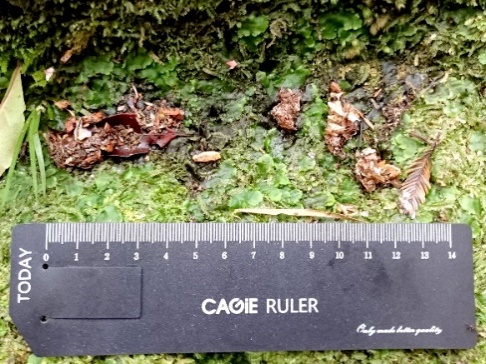
In Baishui River, where spraints were most frequently found, spraints were mainly recorded between 600-700 m asl during December to February, while those in Nanxi and Diaoluo Rivers at altitudes between 900-1,000 m asl in April and May. Except two spraints found in July at Baishui River, no spraint was found during the rainy season from June to September (Fig. 4).
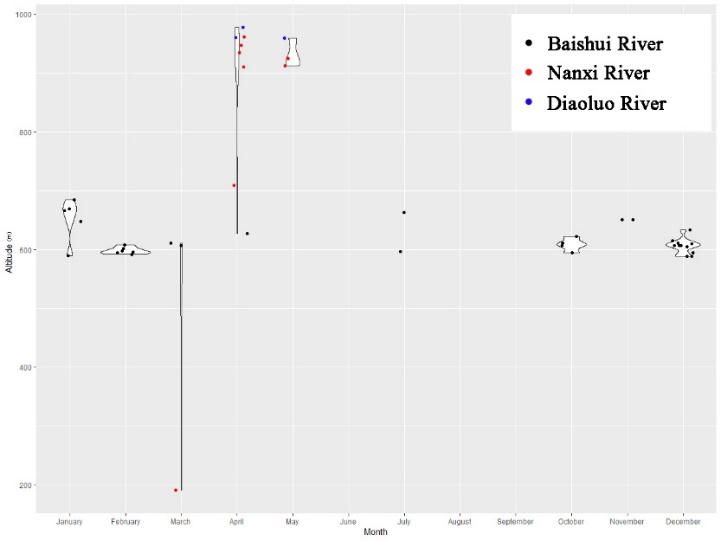
With a total effort of 5,046 trap nights from January 2017 to December 2018, we only obtained three independent images of ASCO at three different locations in Baishui River, each consisted of a single individual (Fig. 5). These images were taken on 24 December 2017 (04:30h), 11 February 2018 (07:01h), and 20 December 2018 (07:07h). We also obtained images of Leopard Cat Prionailurus bengalensis, Masked Palm Civet Paguma larvata and Asiatic Brush-tailed Porcupine Atherurus macrourus from these camera-trap stations. We failed to camera-trap any otters in Nanxi River (419 trap nights) and Diaoluo River (144 trap nights).
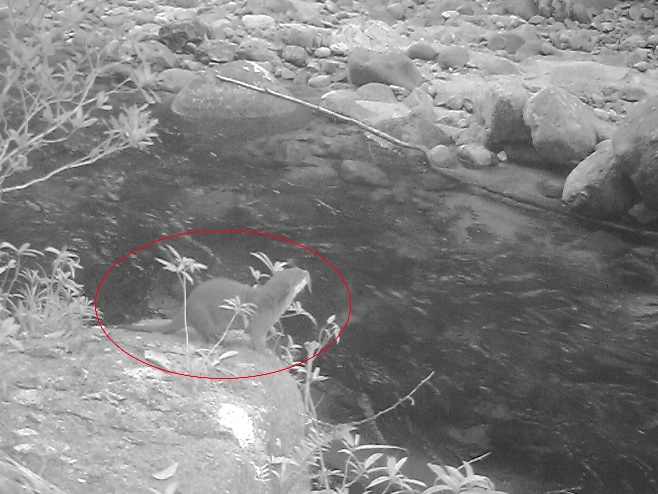
DISCUSSION
In the 2003-2004 study, ASCO spraints and signs were found in Diaoluo River at 760 m asl (Li, 2005). Unfortunately, a hydropower plant was built upstream of this site in 2006, and the stream baseflow becomes minimal and we found no otter sign at this section. Li (2005) reported otter activities were the highest between an elevation band of 650 - 925m asl in Nanxi River, where he found 26 spraints in an eight-month survey. However, a one-hectare horticultural farm has been constructed along this stream in 2007 with much human activities. Although the farm closed down in 2016 some workers were still living in the staff quarters at the time of our study, and our camera-traps recorded frequent illegal human activities such as (electro-)fishing in this section. We spent considerable survey effort in this stream but found only seven spraints, of which six were found above 900 m asl further above the staff quarters. We suspect the high human disturbances is preventing the otters to recolonize the lower stream section.
In the 2006-2009 study, Lei (2009) collected over 80 spraints between 500-650 m asl at Baishui River but during our study we only found 33 spraints in the same stream section. Although the elevation distribution of latrine site shifted slightly upwards to 600-700 m asl, the relatively frequent otter signs suggest Baishui River remains as the key stream for conservation of ASCO at DLSNNR.
While it is exciting to obtain the first image of a wild ASCO from Hainan during our study, the camera-trap results are alarming. Only three independent series of otter images were obtained in 5,046 trap nights, falling far below camera capture rates reported in southern India (Sanghamithra, 2018) and southwestern Yunnan (KFBG, unpublished data). The observed group sizes of ASCO vary from three to five in Bangladesh (Aziz, 2018), four to eight in Borneo (Furuya, 1977), and up to 15 in the Malay peninsula (Foster-Turley 1992). Local residents of DLS reported ASCO previously also formed group; but all of our camera-trap images only consisted of a single ASCO. The extremely low camera-trap detection rate and group size recorded in DLSNNR suggest the local ASCO population is suffering from intense anthropogenic pressures and is under immense threat of local extirpation.
FUTURE WORK
Stepping up patrol effort at key sites appears to be the priority conservation intervention for ASCO of DLSNNR. To allow for the recovery of this relict population, the management of DLSNNR must strictly control unauthorized activities in the Reserve, and to completely evacuate the staff quarters of the derelict horticultural farm at Nanxi River, where ASCO frequented. Further survey is needed to understand the distribution and status of ASCO at the western and northern slopes of the mountains, so as to formulate an emergency conservation action plan for the highly threatened ASCO of Hainan.
Acknowledgements - We are grateful to the Directors of Hainan Wildlife Conservation Bureau and Diaoluoshan Forestry Bureau for granting permissions to conduct the study, and providing essential assistance during fieldwork. We would like to thank a few KFBG colleagues: Zheng Xi, Ren Xiaotong and Ma Ziyu for map and figure preparation; Yang Jianhuan took part in field survey. We sincerely thank members of the Diaoluoshan Asian Small-clawed Otter Monitoring Team, namely Liang Yiwen, Liang Minye and Zheng Yaer for their hard work in the rugged landscape of Mt. Diaoluoshan.
REFERENCES
Aziz, M. A. (2018). Notes on population status and feeding behaviour of Asian Small-clawed otter (Aonyx cinereus) in the Sundarbans mangrove forest of Bangladesh. IUCN/SCC Otter Specialist Group Bulletin, 35(1): 3–10.
Dai, H. Y. (eds). (1999). Fauna sinica: Arthropoda, Crustacea, Malacostraca, Decapoda, Parathelphusidae, Potamidae. Science Press, Beijing, China
Duplaix, N., Savage, M. (2018). The Global Otter Conservation Strategy. IUCN/SSC Otter Specialist Group, Salem, Oregon, USA
Foster-Turley P (1992). Conservation aspects of the ecology of Asian small-clawed and smooth otters on the Malay peninsula. IUCN Otter Specialist Group Bulletin, 7: 26-29.
Furuya Y (1977). Otters in Padas Bay, Sabah, Malaysia (Amblonyx cinerea). Journal of the Mammal Society of Japan, 7: 39-43.
Jiang, H.S. (Eds). (2006). The Biodiversity and its Conservation of Diaoluo Mountain, Hainan, China. Guangdong Science & Technology Press, Guangzhou.
Lei, W. (2009). Geographic Distribution and the Study of Impact Factors on the Otters in Hainan Island. Master Dissertation of Hainan Normal University, Haikou.
Li, F., Chan, B. P. L. (2018). Past and present: the status and distribution of otters (Carnivora: Lutrinae) in China. Oryx, 52(4): 619–626.
Li, X.Z. (eds). (2007). Fauna sinica: Science Press, Beijing, China
Li, Y.C. (2005). Conservation study on two species of Otter in Hainan Island. Annual Report of Pro Natura Fund, vol.14
Sanghamithra, D., Nameer, P. O. (2018). Small carnivores of Silent Valley National Park, Kerala, India. Journal of Threatened Taxa, 10(8): 12091–12097. https://doi.org/10.11609/jott.2992.10.8.12091-12097
Wright, L., de Silva, P., Chan, B., Reza Lubis, I. (2015). Aonyx cinereus. The IUCN Red List of Threatened Species https://dx.doi.org/10.2305/IUCN.UK.2015-2.RLTS.T44166A21939068.en
Xu, L.H. (1984). Species of otters in China and the conservation of their natural resources. Chinese Wildlife, 6: 9-11.
Xu, L.H. (Eds). (1983). Birds and Mammals of Hainan Island. Science Press, Beijing.
Yan, J.A. (2008) Research on the Changes of Ecological Environment of Hainan Island. Science Press, Beijing.
Notes sur la Distribution, le Statut Et l’Écologie de la Loutre Cendrée (Aonyx cinereus) dans la Réserve Naturelle Nationale de Dialoluoshan, Île de Hainan en Chine
En raison de décennies d'exploitation de la faune et de la forêt, les loutres de l'île chinoise de Hainan ont subi un effondrement démographique dramatique. Le dernier signalement confirmé de la loutre cendrée (Aonyx cinereus) au Mont Diaoluoshan dans le sud-est de Hainan, remonte à 2009. Au début de l’année 2017, nous avons lancé un projet de conservation de la loutre cendrée dans la réserve naturelle nationale de Diaoluoshan, à Hainan. Notre travail de terrain a confirmé l’existence pérenne de la loutre cendrée, en faible densité, dans trois grands cours d'eau à moins de 1.000 m d'altitude. Les décapodes étaient les principales sources de nourriture trouvées dans les épreintes. Par rapport aux études précédentes, les latrines semblent s'être déplacées vers l'amont, plus que probablement afin d'éviter les perturbations humaines intenses dans les cours inférieurs des rivières. L'amélioration des efforts de surveillance et la réduction des perturbations humaines sont les clés de la survie de la loutre cendrée, espèce très menacée du Mont Diaoluoshan qui est le seul site protégé pour l'espèce à Hainan.
Revenez au dessus
Resumen: Notas sobre Distribución, Status y Ecología de la Nutria de Uñas Pequeñas Asiática ( Aonyx cinereus ) en la Reserva Natural Diaoluoshan, Isla Hainan, China
Debido a décadas de explotación de la fauna y los bosques, las nutrias en la isla china de Hainan han sufrido una dramáica caída poblacional. El último registro confirmado de Nutria de uñas pequeñas asiática ( Aonyx cinereus ), en el Monte Diaoluoshan en el sureste de Hainan, era de 2009. Al comienzo de 2017, lanzamos un proyecto de conservación de nutrias en la Reserva Natural Nacional Diaoluoshan, Hainan. Nuestro trabajo de terreno confirmó la existencia continua de Nutria de uñas pequeñas asiáticas, en bajas densidades, en tres arroyos importantes por debajo de los 1.000 m s.n.m. Los principales items alimenticios fueron decápodos, en base a las fecas encontradas. En comparación con estudios previos, los sitios de letrinas parecen haberse desplazado aguas arriba, muy probablemente para evitar el intenso disturbio humano en los tramos inferiores. Incrementar el esfuerzo de patrullaje y frenar el disturbio humano son claves para la supervivencia de la altamente amenazada Nutria de uñas pequeñas asiática en Monte Diaoluoshan, que es el único sitio confiable para la especie en Hainan.
Vuelva a la tapa
摘要
海南吊罗山国家级自然保护区亚洲小爪水獭 (Aonyx cinereus) 的分布、状况以及生态研究
由于长期以来对于野生动物及森林的过度利用, 海南岛的水獭种群已明显缩减。 亚洲小爪水獭 (Aonyx cinereus) 自2009年记录于本岛东南部的吊罗山后, 便杳无音讯。 2017年年初, 笔者在海南吊罗山国家级自然保护区启动水獭保护项目, 并在监测工作中再次证明了亚洲小爪水獭的存在。 样线及红外相机的调查结果显示, 亚洲小爪水獭主要在区内海拔1000米以下的河段中活动, 淡水蟹等十足目动物是其主要食物。 水獭的活动海拔与以往的研究相比有所提高, 可能与低海拔的人为干扰相关。 吊罗山是目前海南岛已知保存有水獭种群的唯一地区, 加强低海拔河段的巡护, 有效减少人为干扰是保护并恢复这一种群的关键。
关键词:小爪水獭;分布;状况;保护;水獭粪便
返回頂部